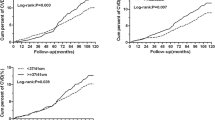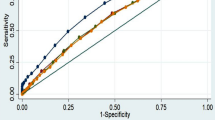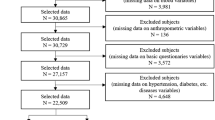Abstract
Objective:
This study examined the association between body mass index (BMI) and waist circumference (WC) and coronary artery disease (CAD) in Taiwanese type 2 diabetic patients.
Methods:
A total of 1183 (558 men and 625 women) patients aged 62.4±11.6 years were studied. CAD was diagnosed by history or an electrocardiogram by Minnesota codes.
Results:
The respective cutoffs of BMI and WC as determined by the receiver operating characteristic curves were 24.5 kg/m2 and 90 cm for men, and 25 kg/m2 and 80 cm for women. Distributions of CAD prevalence and multivariate-adjusted odds ratio (MAOR) for BMI cutoffs of 24.5 and 25 kg/m2 were quite similar in men. MAOR for WC above the respective cutoffs for men and women was 1.832 (1.267–2.648) and 1.450 (0.956–2.200, 0.05<P<0.1), and for BMI⩾25 kg/m2 was 1.759 (1.213–2.551) and 1.471 (1.052–2.058) for men and women, respectively. Patients with BMI⩾25 kg/m2 and WC⩾90 cm for men or ⩾80 cm for women had the highest risk of CAD when compared to those without either risk factor, with respective MAOR of 2.053 (1.352–3.118) and 1.698 (1.071–2.691).
Conclusion:
The recommended BMI and WC cutoffs for obesity for Asian adults are associated with CAD in Taiwanese T2DM.
This is a preview of subscription content, access via your institution
Access options
Subscribe to this journal
Receive 12 print issues and online access
$259.00 per year
only $21.58 per issue
Buy this article
- Purchase on Springer Link
- Instant access to full article PDF
Prices may be subject to local taxes which are calculated during checkout
Similar content being viewed by others
References
Tseng CH . Mortality and causes of death in a national sample of diabetic patients in Taiwan. Diabetes Care 2004; 27: 1605–1609.
Woodward M, Zhang X, Barzi F, Pan W, Ueshima H, Rodgers A, et al. Asia Pacific Cohort Studies Collaboration. The effects of diabetes on the risks of major cardiovascular diseases and death in the Asia-Pacific region. Diabetes Care 2003; 26: 360–366.
Tai TY, Tseng CH . Correlating factors associated with hypertension among non-insulin-dependent diabetes: a cross-sectional study of an epidemiological cohort in Taipei city. Chin J Fam Med 1991; 1: 53–62.
Despres JP . Health consequences of visceral obesity. Ann Med 2001; 33: 534–541.
Tai TY, Chuang LM, Wu HP, Chen CJ . Association of body build with non-insulin-dependent diabetes mellitus and hypertension among Chinese adults: a 4-year follow-up study. Int J Epidemiol 1992; 21: 511–517.
Eckel RH . Obesity and heart disease: A Statement for Healthcare Professionals from the Nutrition Committee, American Heart Association. Circulation 1997; 96: 3248–3250.
Folsom AR, Chambless LE, Duncan BB, Gilbert AC, Pankow JS . Atherosclerosis Risk in Communities Study Investigators. Prediction of coronary heart disease in middle-aged adults with diabetes. Diabetes Care 2003; 26: 2777–2784.
Chambless LE, Folsom AR, Sharrett AR, Sorlie P, Couper D, Szklo M et al. Coronary heart disease risk prediction in the Atherosclerosis Risk in Communities (ARIC) study. J Clin Epidemiol 2003; 56: 880–890.
National Institutes of Health. Clinical guidelines on the identification, evaluation, and treatment of overweight and obesity in adults – the evidence report. Obes Res 1998; 6 (suppl 2): 51S–209S.
World Health Organization. Obesity: Preventing and Managing the Global Epidemic: Report of a WHO Consultation on Obesity. WHO: Geneva, 1998.
WHO expert consultation. Appropriate body-mass index for Asian populations and its implications for policy and intervention strategies. Lancet 2004; 363: 157–163.
World Health Organization. The Asia-Pacific perspective: redefining obesity and its treatment. Available at http://www.iotf.org (accessed 25 April 2005).
Department of Health. Definition and management guidelines for obesity (in Chinese). Available at http://www.doh.gov.tw (accessed 25 April 2005).
Tseng CH . Prevalence and risk factors of peripheral arterial obstructive disease in Taiwanese type 2 diabetic patients. Angiology 2003; 54: 331–338.
Tseng CH, Chong CK, Sheu JJ, Wu TH, Tseng CP . Prevalence and risk factors for stroke in type 2 diabetic patients in Taiwan: a cross-sectional survey of a national sample by telephone interview. Diabetes Med 2005; 22: 477–482.
The Global Lower Extremity Amputation Study Group. Epidemiology of lower extremity amputation in centers in Europe, North America and East Asia. Br J Surg 2000; 87: 328–337.
Tseng CH . Prevalence and risk factors of diabetic foot problems in Taiwan: a cross-sectional survey of non-type 1 diabetic patients from a nationally representative sample (Letters). Diabetes Care 2003; 26: 3351.
Fu CC, Chang CJ, Tseng CH, Chen MS, Kao CS, Wu TJ et al. Development of macrovascular diseases in non-insulin-dependent-diabetics in northern Taiwan: a four-year follow-up study. Diabetes Care 1993; 16: 137–143.
Tseng CH, Chong CK, Lin BJ, Chen CJ, Tai TY . Atherosclerotic risk factors for peripheral vascular disease in non-insulin-dependent diabetic patients. J Formosan Med Assoc 1994; 93: 663–667.
Hedley AA, Ogden CL, Johnson CL, Carroll MD, Curtin LR, Flegal KM . Prevalence of overweight and obesity among US children, adolescents, and adults, 1999–2002. JAMA 2004; 291: 2847–2850.
World Health Organization. Physical Status: the Use and Interpretation of Anthropometry. WHO: Geneva, 1995.
Stevens J . Ethnic-specific cutpoints for obesity vs. country-specific guidelines for action. Int J Obes Relat Metab Disord 2003; 27: 287–288.
Stevens J . Ethnic-specific revisions of body mass index cutoffs to define overweight and obesity in Asians are not warranted. Int J Obes Relat Metab Disord 2003; 27: 1297–1299.
Misra A . Revisions of cutoffs of body mass index to define overweight and obesity are needed for the Asian-ethnic groups. Int J Obes Relat Metab Disord 2003; 27: 1294–1296.
Stevens J, Nowicki EM . Body mass index and mortality in Asian populations: implications for obesity cut-points. Nutr Rev 2003; 61: 104–107.
Huang KC, Lin WY, Lee LT, Chen CY, Lo H, Hsia HH et al. Four anthropometric indices and cardiovascular risk factors in Taiwan. Int J Obes Relat Metab Disord 2002; 26: 1060–1068.
Lin WY, Lee LT, Chen CY, Lo H, Hsia HH, Liu IL et al. Optimal cut-off values for obesity: using simple anthropometric indices to predict cardiovascular risk factors in Taiwan. Int J Obes Relat Metab Disord 2002; 26: 1232–1238.
Acknowledgements
This study was supported by grants from the Department of Health (DOH89-TD-1035) and the National Science Council (NSC-90-2320-B-002-197, NSC-92-2320-B-002-156 and NSC-93-2320-B-002-071), Taiwan.
Author information
Authors and Affiliations
Corresponding author
Rights and permissions
About this article
Cite this article
Tseng, CH. Body mass index and waist circumference as determinants of coronary artery disease in Taiwanese adults with type 2 diabetes mellitus. Int J Obes 30, 816–821 (2006). https://doi.org/10.1038/sj.ijo.0803218
Received:
Revised:
Accepted:
Published:
Issue Date:
DOI: https://doi.org/10.1038/sj.ijo.0803218
Keywords
This article is cited by
-
Relationships of Obesity and Fat Distribution With Atherothrombotic Risk Factors: Baseline Results From the Bypass Angioplasty Revascularization Investigation 2 Diabetes (BARI 2D) Trial
Obesity (2010)
-
Waist Circumference as a Cardiovascular and Metabolic Risk in Japanese Patients With Type 2 Diabetes
Obesity (2009)
-
Response to comment on: Tseng C-H, Tseng C-P, Chong C-K et al (2006) Increasing incidence of diagnosed type 2 diabetes in Taiwan: analysis of data from a national cohort. Diabetologia 49:1755–1760
Diabetologia (2006)



